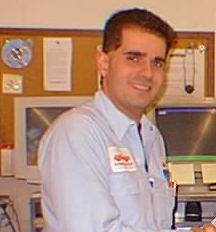Service Dealer Spotlight

Mark Giammalvo specializes in driveability
diagnostics at his family business,
Sam Giammalvo's Auto Sales & Service, Inc. in New
Bedford, MA.
Mark, who has been with the business for
over 20 years, is an ASE Master Technician and Parts Specialist.
He also holds the ASE L1 certification, and has an
associates degree in business management.
Mark is also a writer for Motor Age Magazine and is the past secretary of
the Alliance of Automotive Service Professionals, (AASP).
|

My Version
(April 2001)
History in the making,
the largest automotive recall in U.S. history. But who was really at fault?
Was it Firestone with faulty tires? Was it Ford
with low tire pressure recommendations? I believe it is a condition that
we automotive experts see practically every day. Cracks in the tires tread
area or sidewall. It is the condition that the tire industry calls "weatherchecking"
or "ozone damage" as the term Goodyear has
coined.
At least once per week, if
not more, I am recommending that tires be replaced based on this condition.
There was a time when our shop was fairly lenient about this condition, until
I received a phone call from an upset customer that almost cost me my reputation
let alone a lawsuit. It was several years ago when a good customer asked me
to inspect the tires on her car. The vehicle was a 1991 Buick Riviera and
wore Michelin tires. The customer had a tire failure on the road and the
repairing gas station advised her to replace all the tires due to the cracking
of the rubber in the tread area. I inspected the car on a lift. The cracking
was slight - in its beginning stages. I advised the customer that the problem
was not that critical and that we would inspect them as usual at her next
scheduled tire rotation and balance.
Two weeks later she called me, she sounded very
upset. She had a right to be upset. Driving on Rt. 195 one of the tires
blew out. She nearly lost control. Very, very fortunately, she was not injured.
The car was O.K. She was able to regain control and pull over to the breakdown
lane. Needless to say, we ended up changing the remaining cracked tires.
I have sold many, many different brands
of tires. All with a four-year or better manufacturer's warranty. It is interesting
to note that almost all the tires I see start to crack just after four to
five years from the tires stamped build date. I can not think of a brand
that has not cracked. Recently we had a customer with a 97 Ford Explorer
with 16 inch tires that were NOT recalled. The cracks in the tread area of
those tires were so large that I was able to hide half of a dime in some
of them. If the National Highway and Transportation
Safety Administration forced tire manufacturers to recall tires for weatherchecking
the tire industry would be crippled. Who is to blame? Goodyear representatives
will tell you that this condition is caused by the sun due to the depletion
of the earths ozone layer. Other experts believe the quality of the rubber
used at assembly is to blame.
On a final note, I have recently
sent a letter to the director of the Motorist Assurance Program (MAP). Our
shop is a member and we abide by their automotive repair guidelines. The guidelines
however, do not recommend replacing tires based on a cracking condition.
I have asked them to consider revising the guidelines to recommend replacement.

|